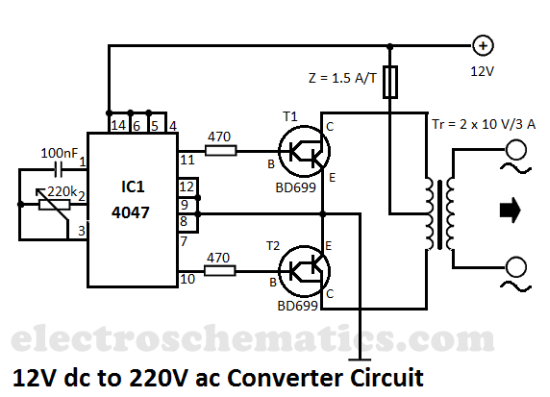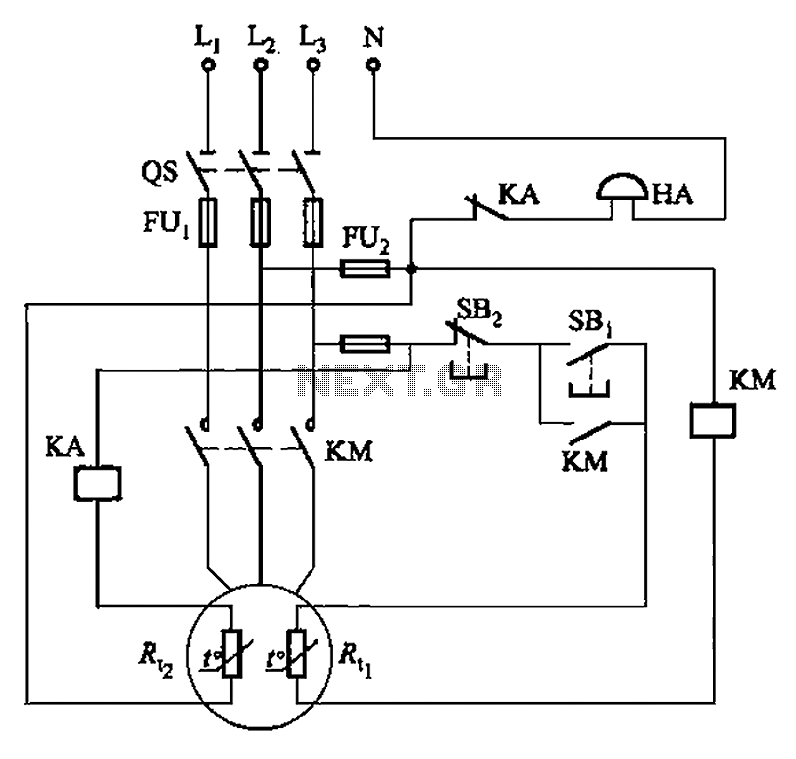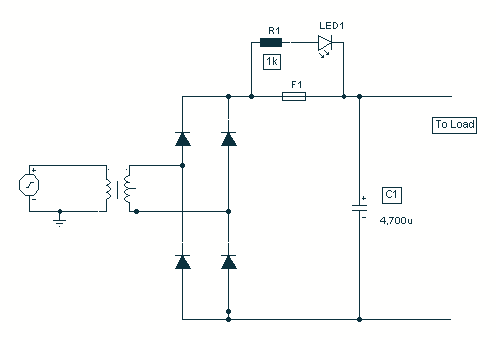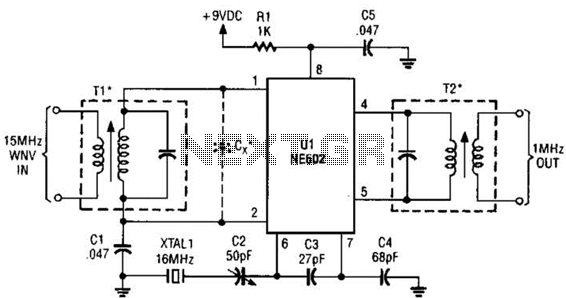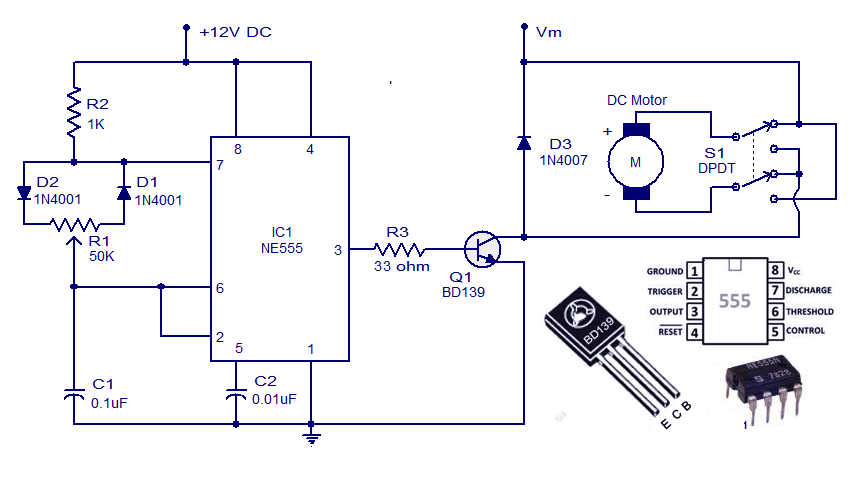
Multi-way pocket alarm circuit

This circuit is a two-way alarm system that utilizes a Schmitt IC, featuring responsive sound and light indicators. It is compact, energy-efficient, and consists of only 13 components, making it a cost-effective solution. The circuit is divided into two sections labeled A, B, and R4, and C, D, and R5. C1 forms the upper limit alarm, while C2 is responsible for the lower limit alarm function, as illustrated in the accompanying schematic. Typically, RP1 and RP2 are used to set the upper and lower alarm thresholds. When inputs A and C are high, the outputs are low, which halts the oscillator. If the temperature exceeds the upper limit, the resistance of thermistor R1 decreases, causing output A and B to activate, resulting in a high-pitched beep from the piezoelectric buzzer YD. Simultaneously, LED1 illuminates to indicate overheating. Conversely, if the temperature falls below the lower limit, the resistance of thermistor R2 increases, triggering outputs C and D, which produces a low-pitched beep from the piezoelectric buzzer YD, with LED2 indicating low temperature. The CMOS circuit operates with minimal static power consumption, typically in the microampere range, primarily due to RP1, RP2, and the thermistors. By selecting thermistors with resistances greater than 100k ohms, and adjusting RP1 and RP2 accordingly, static power consumption can be significantly reduced, thereby extending battery life. The components include: R1, R2 thermistors (1K) - 2 units; R3 resistor (3K) - 1 unit; R4, R5 resistors (2M) - 2 units; RP1, RP2 adjustable resistors (10K linear) - 2 units; C1 polyester capacitor (300pF) - 1 unit; C2 polyester capacitor (1000pF) - 1 unit; LED1, LED2 (3mm) - 1 unit; Schmitt integrated circuit (CD4093 or MC14093) - 1 unit; YD piezoelectric buzzer (20mm HTD20A-1 type) - 1 unit; 12V dedicated small battery - 1 unit. The compact size of the alarm components allows for a design similar to that of a small matchbox. Additionally, by substituting the thermistor with a photosensitive resistor, the circuit can function as a light intensity alarm. The Schmitt trigger can also be configured for dual functionality as a light and temperature alarm, leading to control signals for LED illumination and humidification (ultrasonic humidifier) to create an automated lighting and humidity control system.
This two-way alarm circuit leverages the characteristics of a Schmitt trigger to provide reliable temperature monitoring with both upper and lower limits. The use of thermistors allows for precise temperature sensing, while the piezoelectric buzzer and LEDs serve as effective alert mechanisms. The design's low power consumption is particularly advantageous for battery-operated applications, ensuring prolonged operation without frequent battery replacements. The versatility of the circuit also allows for modifications, such as integrating different sensing elements, to accommodate various environmental monitoring needs. The schematic design should clearly indicate the connections between the components, including the power supply, input sensors, and output indicators, ensuring ease of assembly and troubleshooting.This is a two-way can set the alarm circuit which uses a Schmitt IC, with responsive and sound and light show, small size, low power consumption, all of the elements is only 13, a very low cost. This circuit is divided into two parts by the A, B and R4, C1 composition limit alarm. And in C, D and R5, C2 constitute the lower limit alarm function, the circuit shown in Figure 1.Usually RP1, RP2 are provided two upper and lower alarm point, the A and C inputs are high, the outputs are low leaving the oscillator are halted. When the temperature is too high, the thermistor resistance R1 decreases, the output high A, B start-up, the piezoelectric ceramic YD a high-pitched beep.
At the same time, the light emitting diode LED1 lights on to indicate overheating. When the temperature is too low, the thermistor R2 resistance increases output high of C, D start-up, the piezoelectric sheet issued YD bass tone beep. Light emitting diode LED2 display temperature is too low.Since CMOS circuit static power consumption is extremely small, only microampere current level, so static power consumption mainly in the RP1, RP2 and thermistors.
If we can use resistance at more than a hundred k special temperature resistance, RP1, RP2 a corresponding increase in the scale drawing press, the static power consumption can be controlled very small, it is extremely beneficial to prolong battery life.Component list as follows: Number Name Type Quantity R1,2 thermistor 1K 2 R3 resistance 3K 1 R4,5 resistance 2M 2 RP1,2 adjustable resistor 10K linear 2 Polyester capacitors C1 300P 1 Polyester capacitors C2 1000P 1 LED1,2 emitting diode µ3mm 1 Schmidt integrated circuit or IC CD4093 MC14093 1 YD piezoelectric buzzer µ20mm HTD20A-1 type 1 E battery lighter dedicated 12V small battery 1 The alarm uses the components is not large, do like so small matchbox.If instead of using photosensitive resistance thermistor can be used as the light intensity alarm. It can also be the other input of the Schmitt trigger use down as light, temperature bifunctional two-way alarm.
It leads to a control signal from the LED fill light, humidification (ultrasonic humidifier) to compose automatically fill light and humidity controller.
This two-way alarm circuit leverages the characteristics of a Schmitt trigger to provide reliable temperature monitoring with both upper and lower limits. The use of thermistors allows for precise temperature sensing, while the piezoelectric buzzer and LEDs serve as effective alert mechanisms. The design's low power consumption is particularly advantageous for battery-operated applications, ensuring prolonged operation without frequent battery replacements. The versatility of the circuit also allows for modifications, such as integrating different sensing elements, to accommodate various environmental monitoring needs. The schematic design should clearly indicate the connections between the components, including the power supply, input sensors, and output indicators, ensuring ease of assembly and troubleshooting.This is a two-way can set the alarm circuit which uses a Schmitt IC, with responsive and sound and light show, small size, low power consumption, all of the elements is only 13, a very low cost. This circuit is divided into two parts by the A, B and R4, C1 composition limit alarm. And in C, D and R5, C2 constitute the lower limit alarm function, the circuit shown in Figure 1.Usually RP1, RP2 are provided two upper and lower alarm point, the A and C inputs are high, the outputs are low leaving the oscillator are halted. When the temperature is too high, the thermistor resistance R1 decreases, the output high A, B start-up, the piezoelectric ceramic YD a high-pitched beep.
At the same time, the light emitting diode LED1 lights on to indicate overheating. When the temperature is too low, the thermistor R2 resistance increases output high of C, D start-up, the piezoelectric sheet issued YD bass tone beep. Light emitting diode LED2 display temperature is too low.Since CMOS circuit static power consumption is extremely small, only microampere current level, so static power consumption mainly in the RP1, RP2 and thermistors.
If we can use resistance at more than a hundred k special temperature resistance, RP1, RP2 a corresponding increase in the scale drawing press, the static power consumption can be controlled very small, it is extremely beneficial to prolong battery life.Component list as follows: Number Name Type Quantity R1,2 thermistor 1K 2 R3 resistance 3K 1 R4,5 resistance 2M 2 RP1,2 adjustable resistor 10K linear 2 Polyester capacitors C1 300P 1 Polyester capacitors C2 1000P 1 LED1,2 emitting diode µ3mm 1 Schmidt integrated circuit or IC CD4093 MC14093 1 YD piezoelectric buzzer µ20mm HTD20A-1 type 1 E battery lighter dedicated 12V small battery 1 The alarm uses the components is not large, do like so small matchbox.If instead of using photosensitive resistance thermistor can be used as the light intensity alarm. It can also be the other input of the Schmitt trigger use down as light, temperature bifunctional two-way alarm.
It leads to a control signal from the LED fill light, humidification (ultrasonic humidifier) to compose automatically fill light and humidity controller.

